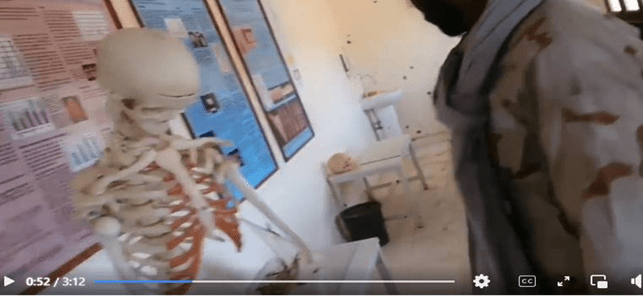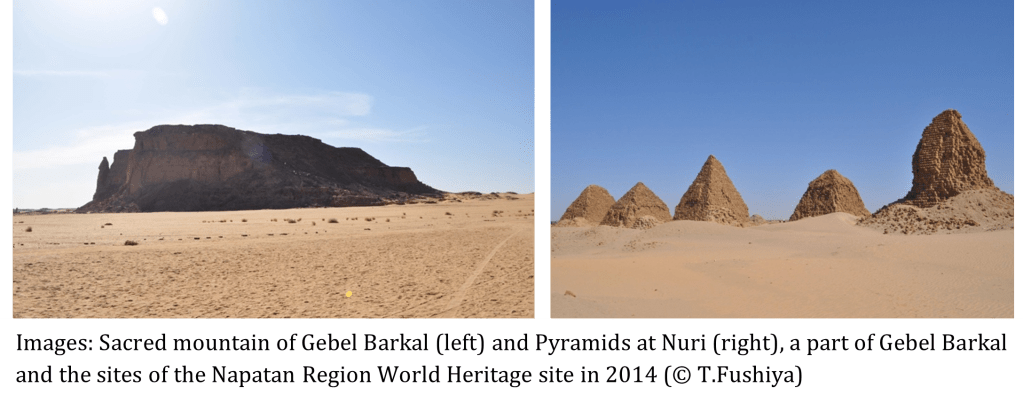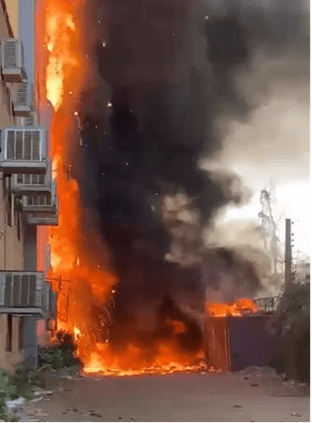The armed conflict in Sudan that erupted on April 15th, 2023, between the Sudanese armed Forces led by General Abdula Fattah Alburhan and the Rapid Support militia (Janjaweed militia) led by Mohamed Hamdan Daglo, is a conflict between two armed factions over the control of the politics and wealth of Sudan. Both sides aligned their brutal forces against the Sudanese popular revolution since 2019 and seized power after the military coup of October 25, 2021. They are responsible for the killing of the revolutionaries, crimes against humanity, genocides across Sudan and the destruction of the country’s fragile infrastructure, including hospitals, schools and Sudan’s heritage sites and history.
In response to the ramifications of this violent conflict, the Heritage for Peace initiative launched the Sudan Heritage Protection Initiative (SHPI) in May 2023.
Subsequently, on June 27, 2023, the SHPI issued its first report on the situation of the cultural heritage in Sudan. Download a copy of the report here or read the full text online below (reproduced with permission of SHPI).
It’s worth noting that MENA Solidarity is hosting a Sudan Solidarity Conference, and Ismail Hamid, one of the authors of this report, will be among our speakers. He will be addressing the cultural heritage situation in Sudan.
You can find additional details about the conference here.
We encourage all our readers to reserve a spot by booking here.
Sudan Heritage Protection Initiative (SHPI)
Ismail Hamid, Mahssin Yusef, Isber Sabrin, Tomomi Fushiya
27 June 2023
News from Sudan Heritage Protection Initiative
The Sudan Heritage Protection Initiative (SHPI) was launched in May 2023 as part of Heritage for Peace, in response to the conflict that erupted in Sudan on 15 April 2023.
Its objectives include:
- Raising awareness about the importance of safeguarding and protecting all cultural heritage in Sudan, regardless of their religious or ethnic identity.
- Documenting and preserving knowledge about the damages inflicted upon cultural heritage in Sudan during the conflict.
- Developing, maintaining, and supporting an extensive network of contacts and volunteers dedicated to the effective safeguarding of cultural heritage in Sudan.
- Providing training, practical knowledge, and simple technologies to protect and preserve Sudan’s cultural heritage under challenging circumstances.
- Facilitating communication and collaboration between heritage workers involved in the protection of Sudan’s cultural heritage and the international heritage community.
SHPI organized a webinar titled “Culture in Crisis: Spotlight in Sudan” on 25 May in collaboration with the Victoria and Albert Museum’s Culture in Crisis program. It was the first event that Sudanese heritage professionals spoke about their heritage. The discussion shed light on the current situation of cultural heritage in Sudan, highlighting the significant challenges of Sudanese colleagues in monitoring and protecting, and the needs of international supports for their efforts.
Members of SHPI were interviewed by BBC World Service Newsdays to speak about the current situation of cultural heritage in Sudan and the activities of SHPI. You can listen to the interview here. Additionally, Bloomberg News published an article titled Race Is On to Protect Sudan’s Pyramids and Tombs as War Rages, highlighting the urgent efforts being made to safeguard these historical sites.
- Dr Isber Sabrine presented SHPI at the international conference entitled, “The Nicosia Convention: a criminal justice response to offences relating to cultural property” in Riga. The conference was organized by the Council of Europe and the Presidency of Latvia and aimed to enhance international cooperation and provide increased protection to the world’s cultural heritage through case-based presentations and productive exchanges. The importance of protecting Sudanese cultural heritage was also highlighted during this significant event.

******
About the photographs in the report
We are using the images of the recent damages that have been widely circulated in social media, please let us know if you are or know the photographer of these images.
Photos by: SHPI Report
Updates on Damage
Khartoum, Omdurman, Bahri areas
- Reem (Reem –ريم on her twitter.) reported on Twitter that the library and archive collection of the Mohamed Omer Bashir Centre for Sudanese Studies at Omdurman Ahlia University were lost in a fire.

- According to the CHML (Cultural Heritage Monitoring and Loss) report in late April, the Natural History Museum in Khartoum suffered significant damage due to a fire. The museum, which is part of the University of Khartoum, housed a collection of rare plants, specimens of species extinct in Sudan, as well as living animals and insects (approximately 100 specimens). Unfortunately, the collection was lost, and the building itself was severely damaged. It is worth noting that the museum is located in an area where the headquarters of the Sudan Armed Force (SAF) is situated, and access to civilians is restricted.
- CHML has reported damage to the shelters that protect the Buhen Temple and the Aksha Temple, which are situated in the garden of the National Museum in Khartoum. The museum is located in close proximity to the Republican Palace, an area that has witnessed intense fighting and bombardment in Khartoum. As a result of the ongoing conflict, it is challenging to ensure a safe passage to the museum, making it difficult to monitor and assess the full extent of the damage incurred.
- The M. Bolheim Bioarchaeology Laboratory was invaded and searched by the RSF (Rapid Support Forces), as depicted in three videos that were shared on social media. These videos include two statements made by individuals who appear to be RSF commanders. The footage suggests that the RSF personnel cleaned up the mess they created in the lab before leaving. The laboratory, which was established in 2009, is situated behind the National Museum in Khartoum. It houses a research lab, a library, offices, and a special storage area designated for storing human remains.


- The Malarmin room of Al Khalifa Museum (Beit Khalifa) is currently occupied by RSF soldiers. Originally serving as the guard room for the residence of Khalifa Abdallahi ibn Mohamed, the successor of Mahdi (Mohamed Ahmed), the museum is located in front of Mahdi’s tomb near the Omdurman market. The residence, which was transformed into a museum, showcases objects and photographs from the Mahdi era and the war against the Anglo-Egyptian army. The building features a traditional Sudanese architectural style, with a spacious open courtyard surrounded by rooms. However, the presence of soldiers in the museum poses a threat to the exhibition and the historical integrity of the building.

- The Old Market of Omdurman has been destroyed by a fire, and several other parts of the Omdurman market, which is the largest market in the Khartoum area, have also suffered damage during the ongoing conflict.

- The Museum of Traditional Musical Instruments is situated approximately 70 meters north of the Sudanese Radio building, which has been subjected to attacks during the conflict.
- Several historical buildings have been damaged in the conflict, including the buildings of the Judicial Authority, the Ministry of Health and Finance, and the Faculty of Medicine at the University of Khartoum. Additionally, the Stack Lab has been occupied by soldiers.
- The conditions of the Museum of Ethnography and the University of Khartoum remain unconfirmed at this time.

- The Abdul Karim Mirghani Center was looted on June 14, 2023. The centre, which was established in May 1998, encompasses a library, research resources, a theatre, and an archive of audio-visual materials such as CDs and cassettes. Additionally, the centre has its own publishing house. Prior to the onset of the conflict, the centre was engaged in the digitization of the archive of the labour movement in Sudan.
- The IRCC (Industrial Research and Consultation Centre) was devastated by a fire on May 6, 2023. This centre played a crucial role in conducting research and analysis, offering information for feasibility studies, performing physical and chemical tests on materials and products, issuing quality certificates, providing training, raising awareness, offering industrial guidance, facilitating technology transfer and localization, and enhancing local technologies. Since 2020, the centre has held the UNESCO Chair for Technology Transfer in Sudan. Unfortunately, the fire resulted in the loss of research data, reports, and the facility itself.
Darfur Region
- In mid-May, the Performing Arts Theatre in el Geneina was tragically burnt down. The city of el Geneina has been deeply affected by intensive violent clashes and a humanitarian crisis resulting from the ongoing conflict since April. The destruction of the theatre adds to the already catastrophic situation in the area.
- All four museums in the Darfur region, namely the Sultan Bahruddin Museum in el Geneina, Nyala Museum, Sheikan Museum in el Obeid, and Sultan Ali Dinar Museum in el Fasher, face significant threats of destruction and looting due to the ongoing conflicts in the area. The Sultan Bahruddin Museum has suffered damage to both a portion of its collections and its historically significant building due to recent bombings in the area. The Nyala Museum’s roof has incurred minor damage from projectiles, leaving the interior vulnerable to rainfall as the rainy season approaches. The Sultan Ali Dinar Museum, located in close proximity to the military territory of the Armed Forces’ Sixth Infantry Division Command, had its building damaged by indiscriminate shelling last week. Given the gravity of the situation in these cities, it is extremely challenging to ascertain the precise extent of the damage to the buildings and collections of the Sultan Bahruddin Museum, Nyala Museum, and Sheikan Museum.

Blue Nile State
- The collection of Sinnar Museum had already been slated for evacuation prior to the conflict due to severe damages and the risk of the building collapsing. Immediate evacuation of the museum collection is imperative in order to safeguard its cultural treasures from further harm.
Northern State and River Nile State
- Two World Heritage Sites, Gebel Barkal and the sites of the Napatan Region, as well as the Archaeological sites of the Island of Meroe, are situated away from direct armed conflicts. However, their remote locations and insufficient security measures make them susceptible to looting and theft. Compounding the issue, a significant number of displaced people have sought refuge in the towns surrounding these sites, leading to the sites being repurposed as shelters for the displaced population. This situation further increases the vulnerability of these important cultural and archaeological sites.


Updates on Looting
- In addition to the destruction of the Mohamed Omar Bashir Centre at Omdurman Ahlia University, The New Arab has reported that other universities, libraries, and research centres have also been subjected to looting. However, no further details or specific information about these incidents are provided in the news article.
Intangible heritage
- Ishraq Wadi, a skilled craftsman renowned for traditional leather shoes known as “Markoub Geneinawi,” was tragically killed in el Geneina. He had been crafting these iconic shoes in the market of el Geneina. This information was reported by Marwa Gibril on Twitter.
Reports and updates from the Sudanese People
- The main gate of The National Records Office (NRO) has suffered partial damage from bomb explosions. While the building itself remains secure at the moment, the glass windows have been shattered. The NRO serves as the National Archives of Sudan and is responsible for the preservation of government records and archives. It houses a vast collection of over 30 million documents, organized into 300 archive collections. These include documents from Sudanese kingdoms, government intelligence, newspapers, photographs, and significant manuscripts, with some items dating as far back as 1504 AD. Unfortunately, due to the ongoing conflict in Khartoum, the building is inaccessible to civilians.
- The Republican Palace Museum, located within the Presidential Palace premises, is facing the imminent threat of destruction. Since the outbreak of the conflict on 15 April 2023, the museum’s main hall and outdoor exhibit, known as the old car gallery, have been at risk. Attached to the museum is a public library that houses valuable books and important archives. According to an eyewitness account, a group of Rapid Support Forces (RSF) soldiers broke into the museum and took control of it. Due to a lack of precise information from reliable sources, the extent of the damage or thefts within the museum remains unclear. Additionally, the nearby historical building of the old palace has suffered damage to its facade. The museum, which was formerly an Anglican church, has been closed to the public since December 2019 and has been guarded by 10-20 soldiers. Images show the main hall of the Palace Museum and the museum building prior to the conflict.

- Reports have also emerged regarding extensive damages, vandalism, fire, shelling, and looting of universities and colleges in Khartoum. Among the affected institutions are the University of AlNeelain, University of Nile, Al-Sudan University, University of Bahari (Al-Kadro and Kharij Complex), Mashreq University, Omdurman Ahlia University, Omdurman Islamic University, International University of Africa, Ahfad University for Women, Ibn Sina University, National University, Napata, College of Science, Al-Yarmouk College, and AlNahda College. Some of these universities are currently occupied by soldiers. The university libraries, archives, and research facilities at these institutions have either been lost or are at significant risk of loss. Furthermore, the building of the Ministry of Higher Education, which holds historical value, has also suffered damage from fire.
- Due to security concerns, the Kerma Museum in the Northern State has been closed to the public. However, the monument of Deffufa in Kerma and the Old Dongola archaeological site are still being visited by some individuals, despite the challenging circumstances.
Policy Changes and Updates from Sudan
- Sara Abdallah Khidir Saeed, the director of the Natural History Museum, has issued a statement outlining the risks that the museums in Khartoum are currently encountering. The statement was published on ICOM Arab’s Twitter. account.
- The National Corporation for Antiquities and Museums (NCAM), the governmental agency tasked with the protection and management of archaeological and historical heritage in Sudan, recently organized a two-day emergency workshop in Cairo. The workshop aimed to develop an emergency response plan in light of the current situation in Sudan. It was attended by representatives from international organizations, directors of international archaeological projects, and funding agencies. The workshop served as a platform for collaboration and strategizing to mitigate the risks facing Sudan’s archaeological and historical sites.
International Activities
- Statements expressing concerns or condemnation of the current situation in Sudan, including the impact on the people, cities, and cultural heritage, have been published by several international organizations and archaeological societies. These organizations include UNESCO, ICOMOS, ICCROM, Cultural Emergency Response, ICOM, and archaeological societies (American Sudanese Archaeological Research Center, International Society for Nubian Studies, and Society for Africanist Archaeologists. The statements reflect their shared commitment to preserving and protecting Sudan’s cultural heritage and highlights the urgency of addressing the challenges faced by the country during this difficult time.
- Cultural Heritage Monitoring Lab (CHML), Virginia Museum of Natural History (VMNH) and the Smithsonian Cultural Rescue Initiative (SCRI) and MAEASam (Mapping Africa’s Endangered Archaeological Sites and Monuments) from the McDonald Institute at the University of Cambridge, are actively involved in monitoring the museums and archaeological sites in Sudan. These organizations are dedicated to assessing and documenting the condition of cultural heritage sites, collecting data, and providing valuable insights into the preservation and protection of Sudan’s rich cultural heritage. Their efforts contribute to the ongoing efforts to safeguard and conserve Sudan’s museums and archaeological treasures.
- The Department of Egyptian and Nubian Archaeology, Faculty of Archaeology, and the Department of African Studies at the Polish Centre of Mediterranean Archaeology, University of Warsaw, recently organized the annual conference “Poles on the Nile”. The conference took place from 21 to the 23 of June and focused on the latest archaeological research and conservation efforts in Sudan. Out of 30 papers presented, 12 papers highlighted the ongoing work and findings in the field of archaeology in Sudan. The conference served as a platform for scholars and researchers to share their knowledge and exchange insights on the rich cultural heritage of Sudan.
- Sudan Day Berlin was held on 24 June, organized by Humboldt-Universität zu Berlin, the Sudan Archaeological Society Berlin (SAG), the Ägyptisches Museum und Papyrussammlung (ÄMP-SMB) and the German Archaeological Institute (DAI Berlin & DAI-KAAK). Archaeological researches conducted by German and Sudanese researchers were presented, see the programme here.
News Update
- The Guardians have reported on the concerning situation of the museum in Khartoum; ‘Staff were forced to abandon the National Museum, which is in central Khartoum and very close to frontlines between the warring factions, after fighting erupted on 15 April, forcing police guarding the facility to leave. One worker at the museum who lived nearby was checking the premises but was recently forced out of his home by the RSF.’ Dr Galia elGarnabi, the Director of the National Museum, has expressed in the article her concerns and called on organizations and individuals who are passionate about heritage to come together and exert pressure on the warring sides. For more detailed information, you can refer to the article “Sudan officials fear for historical artifacts threatened by fighting” mentioned in The Guardians’ report.
This report was compiled together with our collaborators currently in Sudan who are archaeologists, historians, archivists, librarians, university professors, students and volunteers. For security reasons, we do not mention their names in the report.





